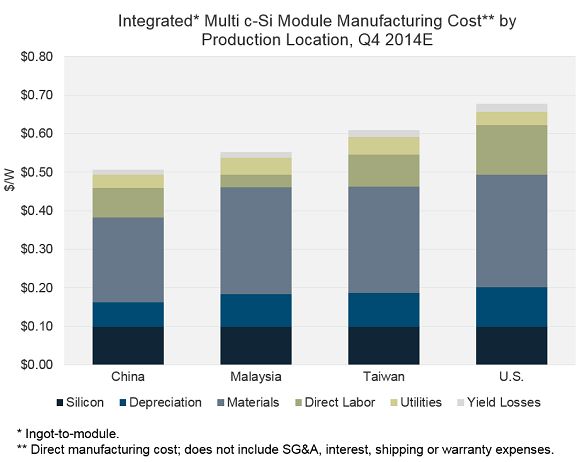In four of the industry's top solar manufacturing markets, manufacturing costs for multicrystalline silicon modules vary by up to 18 cents per watt. Assuming identical plant scale and value chain participation, GTM Research's analysis in its November PV Pulse shows that factories based in China have the lowest module manufacturing costs, followed by Malaysia, Taiwan and the U.S.
China's direct manufacturing cost, which does not include selling, general and administrative costs, interest, shipping, or warranty expenses, is 50 cents per watt.

Source: GTM Research PV Pulse, November 2014
According to the report, the primary source of China’s manufacturing cost advantage is lower pricing for key consumables along the PV value chain, mainly due to a large and competitive domestic ecosystem for materials like slurry, sawing wire, junction boxes, and frames. Production costs for Chinese material vendors (e.g., Xingda, Hangzhou First PV) are lower than they are for their Western counterparts, driving lower pricing.
GTM Research lead upstream solar analyst Shyam Mehta notes that many domestic consumables vendors are pure-play solar firms that rely on their component customers for revenue, meaning that component producers can exert significant pricing leverage on their vendors. Many larger wafer, cell and module vendors also produce key consumables internally (e.g., crucibles, wire, frames, junction boxes).
Malaysia is estimated to currently have the lowest direct labor costs on a per-watt basis due to a high degree of automation at Malaysian factories and low wage/salary rates, even compared to China. The availability of cheap and skilled labor (due to the country's prior experience with semiconductor manufacturing) has made Malaysia a popular location for many PV manufacturers, including SunPower (cells), Flextronics (modules), Hanwha Q-Cells (cells), and Comtec Solar (ingots/wafers).
Companies located in the U.S. can produce a multicrystalline silicon module for 68 cents per watt. In light of the recent U.S. plant opening announcements from SolarWorld and SolarCity, it will be interesting to keep an eye on U.S. manufacturing costs.
"Both of these facilities focus on higher-efficiency technology that has historically been more costly to produce," said GTM Research solar analyst Jade Jones. "There's the question not only of manufacturing location, but also of the producers' ability to bring down the cost for various technology solutions."




